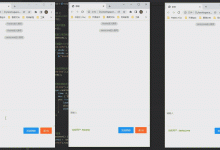本文内容
-
Resource
接口的定义
-
Resource
接口的内置实现
-
ResourceLoader
接口
-
ResourceLoaderAware
接口
Resource接口的定义
Java 的标准
java.net.URL
类和各种
URL
前缀的标准处理程序不足以满足所有对低级资源的访问。 例如没有标准化的
URL
实现可用于访问需要从类路径或相对于
ServletContext
获取的资源。 虽然可以为专门的 URL 前缀注册新的处理程序(类似于现有的前缀处理程序如
http:
),但这通常相当复杂,并且 URL 接口仍然缺乏一些理想的功能,例如检查是否存在的方法 指向的资源。
针对上述这种情况,Spring 提供了更强大的接口
Resource
用于对低级资源的抽象访问,其定义和主要接口方法说明如下。
package org.springframework.core.io;public interface Resource extends InputStreamSource {// 特定资源是否存在boolean exists();// 内容非空可通过#getInputStream()读取default boolean isReadable() {return exists();}// 资源对应的InputStream是否已经打开,不能多次读取,应读取后关闭避免资源泄漏default boolean isOpen() {return false;}// 是否是 File 类型,配合 #getFile()default boolean isFile() {return false;}// 获取 URLURL getURL() throws IOException;// 获取URIURI getURI() throws IOException;// 获取 FileFile getFile() throws IOException;// 资源内容长度long contentLength() throws IOException;// 上次修改的时间戳long lastModified() throws IOException;// 给定路径创建资源Resource createRelative(String relativePath) throws IOException;// 获取文件名非全路径@NullableString getFilename();// 获取资源描述String getDescription();}
Resource
接口继承了
InputStreamSource
,其定义如下。
package org.springframework.core.io;public interface InputStreamSource {// 获取资源对应的 InputStreamInputStream getInputStream() throws IOException;}
Resource
接口并不是用于完全取代
java.net.URL
,而是尽可能地通过其实现类来包装
URL
进行处理,如
UrlResource
包装一个
URL
并使用包装的
URL
来完成它的的功能。具体看下一节的内置实现。
Resource接口的内置实现
-
UrlResource
-
ClassPathResource
-
FileSystemResource
-
ServletContextResource
-
InputStreamResource
-
ByteArrayResource
UrlResource
UrlResource
包装了
java.net.URL
,可用于访问通常可通过
URL
访问的任何对象,例如文件、HTTP 目标、FTP 目标等。这些资源通过标准前缀来区分,
file:
用于访问文件系统路径,
http:
用于通过 HTTP 协议访问资源,
ftp:
用于通过 FTP 访问资源等。
ClassPathResource
ClassPathResource
表示应从类路径获取的资源。它使用线程上下文类加载器、给定的类加载器或给定的类来加载资源。可通过特定前缀
classpath:
指定为该资源。
如果类路径资源驻留在文件系统中,则此
Resource
实现支持解析为
java.io.File
,但不支持在 jar 包中且尚未解压的类路径资源。
FileSystemResource
这是
java.io.File
和
java.nio.file.Path
句柄的资源实现。它支持作为
File
和
URL
的解析。
ServletContextResource
这是
ServletContext
资源的
Resource
实现,它解释相关 Web 应用程序根目录中的相对路径。
它始终支持流访问和
URL
访问,但仅在扩展 Web 应用程序存档并且资源物理位于文件系统上时才允许
java.io.File
访问。它是否被解压并在文件系统上或直接从 JAR 或其他地方(如数据库)访问实际上取决于 Servlet 容器。
ByteArrayResource
给定字节数组的资源实现。它为给定的字节数组创建一个
ByteArrayInputStream
。对于从任何给定的字节数组加载内容很有用,而不必求助于单一使用的
InputStreamResource
。
InputStreamResource
InputStreamResource
是给定
InputStream
的资源实现。首选
ByteArrayResource
或任何基于文件的
Resource
实现,仅当没有特定的
Resource
实现适用时才应使用它。
与其他 Resource 实现相比,这是一个已打开资源的描述符,接口
isOpen()
返回
true
。如果需要将资源描述符保存在某处或需要多次读取流,请不要使用它。
ResourceLoader
接口
ResourceLoader 用于加载资源(例如类路径或文件系统资源)的策略接口。
package org.springframework.core.io;public interface ResourceLoader {/** Pseudo URL prefix for loading from the class path: "classpath:". */String CLASSPATH_URL_PREFIX = ResourceUtils.CLASSPATH_URL_PREFIX;// 返回指定资源位置的资源句柄Resource getResource(String location);// 获取 ClassLoader// 需要直接访问 ClassLoader 的客户端可以通过 ResourceLoader 统一的方式进行访问,而不是依赖于线程上 下文 ClassLoader。@NullableClassLoader getClassLoader();}
源码中对于的说明:
- 句柄应始终是可重用的资源描述符,允许多个 Resource.getInputStream() 调用。
- 必须支持完全限定的 URL,例如“
file:C:/test.dat
”。
- 必须支持类路径伪 URL,例如“
classpath:test.dat
”。
- 应该支持相对文件路径,例如“
WEB-INF/test.dat
”。 (这将是特定于实现的,通常由
ApplicationContext
实现提供。)
- 资源句柄并不意味着现有资源;需要调用
Resource.exists()
来检查是否存在。
所有
org.springframework.context.ApplicationContext
都必须实现该
ResourceLoader
接口。调用
getResource()
接口的返回值类型取决于当前context的类型,当前context会自动转换。如下案例。
Resource template = ctx.getResource("some/resource/path/myTemplate.txt");
如
ctx
是
ClassPathXmlApplicationContext
返回
ClassPathResource
;
如
ctx
是
FileSystemXmlApplicationContext
返回
FileSystemResource
;
如
ctx
是WebApplicationContext返回
ServletContextResource
如果不想依赖
context
类型决定返回资源的类型,可以指定前缀的方式,强制返回特定类型的资源。如下案例。
Resource template = ctx.getResource("classpath:some/resource/path/myTemplate.txt");// 返回 ClassPathResource
Resource template = ctx.getResource("file:///some/resource/path/myTemplate.txt");Resource template = ctx.getResource("https://myhost.com/resource/path/myTemplate.txt");// 返回 UrlResource
指定前缀对于资源加载方式和返回的影响对应关系如下表。
| 前缀 | 例子 | 如何解析 || :——— | :———————————————————– | :——————————– || classpath: |
classpath:com/myapp/config.xml
| 从类路径加载 || file: |
file:///data/config.xml | 从文件系统作为
URL
加载 | | | http: |
Java开发/logo.png` | 从文件系统作为
URL
加载 || (none) |
/data/config.xml
| 取决于底层的
ApplicationContext
|
ResourceLoaderAware
接口
ResourceLoaderAware
接口是一个特殊的回调接口,它标识期望提供
ResourceLoader
引用的组件。其定义如下。
package org.springframework.context;public interface ResourceLoaderAware extends Aware {// 可自定义保存一个ResourceLoader的引用来进行资源加载void setResourceLoader(ResourceLoader resourceLoader);}
由于
org.springframework.context.ApplicationContext
实现了
ResourceLoader
,因此 bean 还可以实现
ApplicationContextAware
接口并直接使用提供的应用程序上下文来加载资源。从面向接口编程和解耦的角度来说,需要
ResourceLoader
的来进行资源加载,更推荐实现“ResourceLoaderAware
接口。
深一层思考,如果容器中的一个bean需要一个
ResourceLoader
依赖用于加载资源,除了实现
ResourceLoaderAware
,是否还有其它方式呢?
ResourceLoader
实例会自动注入到IoC容器,我们可通过构造函数、setter方法、@Autowire注解等方式,直接注入该依赖,具体看一看之前Ioc相关的文章。
配置文件当做
Resource
注入到bean依赖中
如果某个bean依赖于特定的
Resource
,那么我们如何快速优雅地注入该依赖呢?直接上代码。
public class MyConfig {/*** 通过配置文件注入的资源*/private Resource template;public Resource getTemplate() {return template;}public void setTemplate(Resource template) {this.template = templa}}
MyConfig
依赖一个类文件路径下的一个配置文件。
对应的xml文件
spring.xml
和配置文
db.properties
件如下:
<?xml version="1.0" encoding="UTF-8"?><beans xmlns="http://www.springframework.org/schema/beans"xmlns:xsi="http://www.w3.org/2001/XMLSchema-instance"xsi:schemaLocation="http://www.springframework.org/schema/beans http://www.springframework.org/schema/beans/spring-beans.xsd"><bean id="myConfig" class="com.crab.spring.ioc.demo02.MyConfig"><property name="template" value="db.properties"></property></bean></beans>
url=jdbc:mysql://localhost/testusername=rootpassword=456max=1024
运行主程序如下:
package com.crab.spring.ioc.demo02;import org.springframework.context.support.ClassPathXmlApplicationContext;import org.springframework.core.io.ClassPathResource;import org.springframework.core.io.Resource;public class ResourceTest {public static void main(String[] args) {ClassPathXmlApplicationContext context = new ClassPathXmlApplicationContext("spring" +".xml");MyConfig myConfig = context.getBean(MyConfig.class);Resource template = myConfig.getTemplate();System.out.println(template);System.out.println(template instanceof ClassPathResource);}}
运行结果:
class path resource [db.properties]trueclass path resource [db.properties]
- 成功注入了
Resourece
资源到
MyConfig
的bean中
- 注入
Resource
实际是我们通过
ClassPathXmlApplicationContext
加载的
ClassPathResource
扩展:结合上一篇的资源特定前缀和
ApplicationContext
的关系,忘了请翻看下,我们也可以指定前缀来加载特定的资源。较为简单就不演示了。
<bean id="myConfig" class="com.crab.spring.ioc.demo02.MyConfig"><property name="template" value="classpath:db.properties"></property></bean>file:///some/resource/path
<bean id="myConfig" class="com.crab.spring.ioc.demo02.MyConfig"><property name="template" value="file:///some/resource/path"></property></bean>// 注入的是FileSystemResource
使用资源路径配置应用上下文
回顾一下,
ResourceLoader
章节,我们分析了指定资源路径前缀对于资源加载方式的影响,对应关系如下表。下面将分带前缀和不带前缀的方式来配置应用上下文。
| 前缀 | 例子 | 如何解析 || :——— | :———————————————————– | :——————————– || classpath: |
classpath:com/myapp/config.xml
| 从类路径加载 || file: |
file:///data/config.xml | 从文件系统作为
URL
加载 | | | http: |
Java开发/logo.png` | 从文件系统作为
URL
加载 || (none) |
/data/config.xml
| 取决于底层的
ApplicationContext
|
资源路径不带前缀
ApplicationContext ctx = new ClassPathXmlApplicationContext("conf/appContext.xml");
上面这个案例资源路径不带前缀,
ClassPathXmlApplicationContext
将使用
ClassPathResource
加载在类路径下的资源文件。再来一个案例。
ApplicationContext ctx = new FileSystemXmlApplicationContext("conf/appContext.xml");
FileSystemXmlApplicationContext
将使用
URLResouce
来加载文件系统中的配置文件,这里案例是相对路径。
资源路径带前缀
当指定了资源前缀,则使用指定前缀对应的
Resource
来加载资源。如下案例。
ApplicationContext ctx =new FileSystemXmlApplicationContext("classpath:conf/appContext.xml");
对比上一个案例,此处将使用
ClassPathResource
加载在类路径下的资源文件。
资源路径带前缀和通配符
指定单一的资源文件通过前面2种方式,若需要指定多个资源则可以考虑使用通配符,支持
Ant-style
和
classpath*
。
-
Ant-style
通配符
/WEB-INF/*-context.xmlcom/mycompany/**/applicationContext.xmlfile:C:/some/path/*-context.xmlclasspath:com/mycompany/**/applicationContext.xml
当使用
Ant-style
通配符,解析器遵循更复杂的过程来尝试解析通配符。它为直到最后一个非通配符段的路径生成一个资源,并从中获取一个
URL
。它为直到最后一个非通配符段的路径生成一个资源,并从中获取一个
URL
。
最后一个非通配符段的路径分2种情况处理:
普通的文件路径: 生成
java.io.File
,如
classpath:com/mycompany/**/applicationContext.xml
取到
classpath:com/mycompany
,然后进行遍历。
-
特殊的文件
jar:
路径:如
classpath:com/mycompany/**/applicationContext.xml
,取到
classpath:com/mycompany
,将生成
java.net.JarURLConnection
,或是手动解析 jar
URL
然后遍历 jar 文件的内容来解析通配符。
使用 jar
URL
强烈建议测试下是否能正常通过通配符访问到资源
-
classpath*
前缀
如下案例
ApplicationContext ctx =new ClassPathXmlApplicationContext("classpath*:conf/appContext.xml");遍历类路径下所有匹配到
conf/appContext.xml
的资源都会加载。
-
两种方式可以组合使用
如
classpath*:META-INF/*-beans.xml
解决策略相当简单:在最后一个非通配符路径段上使用 ClassLoader.getResources() 调用来获取类加载器层次结构中的所有匹配资源,然后对于每个资源,
PathMatcher
解析策略用于通配符子路径。感兴趣的可以了解下
PathMatcher
类。
组合使用容易掉坑的2个地方,请注意:
classpath*:*.xml
可能不会从 类路径下的jar 文件的根目录中检索文件,而只能从扩展目录的根目录中检索文件。
-
classpath:com/mycompany/**/service-context.xml
如果要搜索的根包在多个类路径位置中可用,则不保证资源能够找到匹配的资源。 使用
ClassLoader#getResource(com/mycompany/)
如果多个路径有,则可能只返回第一个,其它的漏掉了。保险的做法是
classpath*:com/mycompany/**/service-context.xml
彩蛋
出于向后兼容的历史原因,
FileSystemXmlApplicationContext
关联的
FileSystemResource
会将所有的资源的非前缀路径统一当做相对路径。上案例
// 2种写法是一样的ApplicationContext ctx =new FileSystemXmlApplicationContext("conf/context.xml");ApplicationContext ctx =new FileSystemXmlApplicationContext("/conf/context.xml");// 2种写法是一样的ctx.getResource("some/resource/path/myTemplate.txt");ctx.getResource("/some/resource/path/myTemplate.txt");// 可以强制不按相对路径处理不,可以的!按URLResource处理ctx = new FileSystemXmlApplicationContext("file:///conf/context.xml");
总结
本文主要详细说明了
-
Resource
接口的定义和方法说明
-
Resource
接口的内置6种实现
-
ResourceLoader
接口和实现
-
ResourceLoaderAware
接口使用
- 如何使用
Resource
配置
ApplicationContext
这一篇下来,基本Spring关于资源处理和相关接口总体是比较清晰了。
知识分享,转载请注明出处。学无先后,达者为先!
 爱站程序员基地
爱站程序员基地


